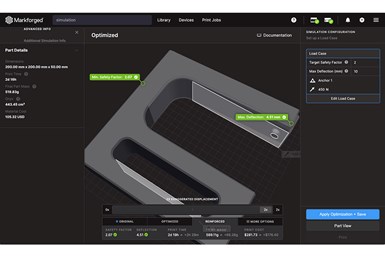Markforged 3D Printing Simulation Software Validates Composite Part Strength
The virtual testing validates the strength of advanced composite parts and automatically optimizes print parameters to lower cost and speed production.
Markforged has added simulation features to its additive manufacturing (AM) software, which is available as a free trial until April 2023, and thereafter as a paid subscription.
Incorporating 3D printing into tooling and end-use applications requires total confidence in part strength. By replacing slow and costly design/print/break testing cycles with virtual testing, Simulation enables manufacturers to expand their use of additive manufacturing into the most demanding production applications.
Larsen Motorsports builds jet engine drag racing vehicles that hurtle past 280 mph. But stock aluminum steering wheels are shaped for much larger hands than those of their award-winning driver, Josette Roach, putting safety and performance at risk. Larsen Motorsports used simulation to design and print a continuous carbon fiber-reinforced Onyx steering wheel strong enough to replace aluminum. “We can now test it with simulation, iterate and keep iterating until we get a design we're happy with,” says Brian Tocci, director of Operations, Larsen Motorsports. “We don't have to print 10 different parts. We can do it all in simulation."
Unlike traditional software tools that need specialized expertise and time-consuming analysis, simulation is designed for AM and works within the familiar Eiger slice-and-print workflow. Any user can validate part strength and stiffness through virtual testing by identifying anchor and load surfaces, and then entering values for loads, factor of safety and maximum deflection. They then optimize parts by automatically determining print settings for floors, walls, infill and fiber reinforcement to achieve cost and speed goals while maintaining adequate strength.
“Simulation enables our customers to adopt The Digital Forge deeper into their manufacturing operations by replacing more mission-critical tooling and end-use metal parts with validated and optimized 3D printed advanced composite parts with continuous fiber reinforcement,” says Shai Terem, president and CEO of Markforged. “Cloud-based software innovation like simulation is core to our mission to bring industrial part production to the point of need.”
Markforged says its Digital Forge is a reliable, intelligent and easy-to-use AM platform, empowering manufacturers to create robust end-use parts in both metal and composites anywhere and anytime.
- Read about Markforged reformulating H13, D2 tool steel for more flexible, less brittle filaments. The new filaments are reformulations of Markforged’s most popular tool steels.
- Learn more about Markforged’s Digital Source Platform which enables printing parts on-demand. The platform enables manufacturer-certified parts to be licensed and printed at the point of need.
Related Content
-
How Norsk Titanium Is Scaling Up AM Production — and Employment — in New York State
New opportunities for part production via the company’s forging-like additive process are coming from the aerospace industry as well as a different sector, the semiconductor industry.
-
Additive Manufacturing Is Subtractive, Too: How CNC Machining Integrates With AM (Includes Video)
For Keselowski Advanced Manufacturing, succeeding with laser powder bed fusion as a production process means developing a machine shop that is responsive to, and moves at the pacing of, metal 3D printing.
-
3D Printed Titanium Replaces Aluminum for Unmanned Aircraft Wing Splice: The Cool Parts Show #72
Rapid Plasma Deposition produces the near-net-shape preform for a newly designed wing splice for remotely piloted aircraft from General Atomics. The Cool Parts Show visits Norsk Titanium, where this part is made.















